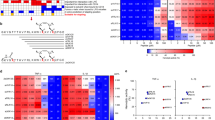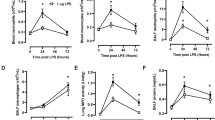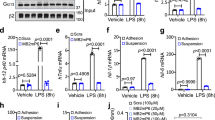Abstract
We describe a new therapeutic approach for the treatment of lethal sepsis using cell-penetrating lipopeptides—termed pepducins—that target either individual or multiple chemokine receptors. Interleukin-8 (IL-8), a ligand for the CXCR1 and CXCR2 receptors, is the most potent endogenous proinflammatory chemokine in sepsis. IL-8 levels rise in blood and lung fluids to activate neutrophils and other cells, and correlate with shock, lung injury and high mortality1,2,3,4,5. We show that pepducins derived from either the i1 or i3 intracellular loops of CXCR1 and CXCR2 prevent the IL-8 response of both receptors and reverse the lethal sequelae of sepsis, including disseminated intravascular coagulation and multi-organ failure in mice. Conversely, pepducins selective for CXCR4 cause a massive leukocytosis that does not affect survival. CXCR1 and CXCR2 pepducins conferred nearly 100% survival even when treatment was postponed, suggesting that our approach might be beneficial in the setting of advanced disease.
This is a preview of subscription content, access via your institution
Access options
Subscribe to this journal
Receive 12 print issues and online access
$209.00 per year
only $17.42 per issue
Buy this article
- Purchase on Springer Link
- Instant access to full article PDF
Prices may be subject to local taxes which are calculated during checkout




Similar content being viewed by others
References
Hack, C.E. et al. Interleukin-8 in sepsis: relation to shock and inflammatory mediators. Infect. Immun. 60, 2835–2842 (1992).
Friedland, J.S. et al. Prolonged elevation of interleukin-8 and interleukin-6 concentrations in plasma and of leukocyte interleukin-8 mRNA levels during septicemic and localized Pseudomonas pseudomallei infection. Infect. Immun. 60, 2402–2408 (1992).
Miller, E.J. et al. Elevated levels of NAP-1/interleukin-8 are present in the airspaces of patients with the adult respiratory distress syndrome and are associated with increased mortality. Am. Rev. Respir. Dis. 146, 427–432 (1992).
Endo, S. et al. Plasma interleukin 8 and polymorphonuclear leukocyte elastase concentrations in patients with septic shock. J. Inflamm. 454, 136–142 (1995).
Redl, H. et al. Plasma neutrophil-activating peptide-1/interleukin-8 and neutrophil elastase in a primate bacteremia model. J. Infect. Dis. 164, 383–388 (1991).
Riedemann, N.C., Guo, R.F. & Ward, P.A. Novel strategies for the treatment of sepsis. Nat. Med. 9, 517–524 (2003).
Wheeler, A.P. & Bernard, G.R. Treating patients with severe sepsis. N. Engl. J. Med. 340, 207–214 (1999).
Bone, R.C. Toward a theory regarding the pathogenesis of the systemic inflammatory response syndrome: what we do and do not know about cytokine regulation. Crit. Care Med. 24, 163–172 (1996).
Nichols, R.L. et al. Risk of infection after penetrating abdominal trauma. N. Engl. J. Med. 311, 1065–1070 (1984).
Dinarello, C.A., Gelfand, J.A. & Wolff, S.M. Anticytokine strategies in the treatment of the systemic inflammatory response syndrome. JAMA 269, 1829–1835 (1993).
Matsukawa, A., Hogaboam, C.M., Lukacs, N.W. & Kunkel, S.L. Chemokines and innate immunity. Rev. Immunogenet. 2, 339–358 (2000).
Taub, D.D. The voodoo that they do so well. Cytokine Growth Factor Rev. 7, 355–376 (1996).
Ness, T.E., Hogaboam, C.M., Strieter, R.M. & Kunkel, S.L. Immunomodulatory role of CXCR2 during experimental septic peritonitis. J. Immunol. 171, 3775–3784 (2003).
Gando, S. et al. Combined activation of coagulation and inflammation has an important role in multiple organ dysfunction and poor outcome after severe trauma. Thromb. Haemost. 88, 943–949 (2002).
Levi, M. & Cate, H.T. Disseminated intravascular coagulation. N. Engl. J. Med. 341, 586–592 (1999).
Allen, C.D. et al. Germinal center dark and light zone organization is mediated by CXCR4 and CXCR5. Nat. Immunol. 5, 943–952 (2004).
Martin, C. et al. Chemokines acting via CXCR2 and CXCR4 control the release of neutrophils from the bone marrow and their return following senescence. Immunity 19, 583–593 (2003).
Darash-Yahana, M. et al. Role of high expression levels of CXCR4 in tumor growth, vascularization, and metastasis. FASEB J. 18, 1240–1242 (2004).
Bertini, R. et al. Noncompetitive allosteric inhibitors of the inflammatory chemokine receptors CXCR1 and CXCR2: prevention of reperfusion injury. Proc. Natl. Acad. Sci. USA 101, 11791–11796 (2004).
Lomas-Neira, J.L., Chung, C.S., Grutkoski, P.S., Miller, E.J. & Ayala, A. CXCR2 inhibition suppresses hemorrhage-induced priming for acute lung injury in mice. J. Leukoc. Biol. 76, 58–64 (2004).
Covic, L., Gresser, A.L., Talavera, J., Swift, S. & Kuliopulos, A. Activation and inhibition of G protein-coupled receptors by cell-penetrating membrane-tethered peptides. Proc. Natl. Acad. Sci. USA 99, 643–648 (2002).
Covic, L., Misra, M., Badar, J., Singh, C. & Kuliopulos, A. Pepducin-based intervention of thrombin receptor signaling and systemic platelet activation. Nat. Med. 8, 1161–1165 (2002).
Boire, A. et al. PAR1 is a Matrix metalloprotease-1 receptor that promotes invasion and tumorigenesis of breast cancer cells. Cell 120, 303–313 (2005).
Suratt, B.T. et al. Role of the CXCR4/SDF-1 chemokine axis in circulating neutrophil homeostasis. Blood 104, 565–571 (2004).
Bonecchi, R. et al. Induction of functional IL-8 receptors by IL-4 and IL-13 in human monocytes. J. Immunol. 164, 3862–3869 (2000).
Cacalano, G. et al. Neutrophil and B cell expansion in mice that lack the murine IL-8 receptor homolog. Science 265, 682–684 (1994).
Skelton, N.J., Quan, C., Reilly, D. & Lowman, H. Structure of a CXC chemokine-receptor fragment in complex with interleukin-8. Structure Fold Des. 7, 157–168 (1999).
Kuliopulos, A. & Walsh, C.T. Production, purification, and cleavage of tandem repeats of recombinant peptides. J. Am. Chem. Soc. 116, 4599–4607 (1994).
Wiedermann, C.J., Niedermuhlbichler, M. & Braunsteiner, H. Priming of polymorphonuclear neutrophils by atrial natriuretic peptide in vitro. J. Clin. Invest. 89, 1580–1586 (1992).
Covic, L., Gresser, A.L. & Kuliopulos, A. Biphasic kinetics of activation and signaling for PAR1 and PAR4 thrombin receptors in platelets. Biochemistry 39, 5458–5467 (2000).
Acknowledgements
We thank L. Covic for advice and comments on the manuscript, J. Yu for construction of stable CXCR1/2/4 HEK cell lines and lipidation of pepducins, B. Tchernychev for development of pepducin dosages and delivery, and S. Swift and S. Jacques for help in production of recombinant SDF-1α and IL-8. The support from the FWF Austrian Science Foundation (Erwin Schrodinger Fellowship
Author information
Authors and Affiliations
Corresponding author
Ethics declarations
Competing interests
The authors declare no competing financial interests.
Supplementary information
Supplementary Fig. 1
Chemokine pepducins are selective for their cognate receptors. (PDF 106 kb)
Supplementary Fig. 2
Effect of CXCR1/2 pepducins on eupathy in septic mice. (PDF 178 kb)
Supplementary Fig. 3
CXCR1/2 pepducins protect against lung injury and inhibit IL-8-dependent activity of several cell types. (PDF 370 kb)
Rights and permissions
About this article
Cite this article
Kaneider, N., Agarwal, A., Leger, A. et al. Reversing systemic inflammatory response syndrome with chemokine receptor pepducins. Nat Med 11, 661–665 (2005). https://doi.org/10.1038/nm1245
Received:
Accepted:
Published:
Issue Date:
DOI: https://doi.org/10.1038/nm1245
This article is cited by
-
Immunotherapy of Sepsis: Blind Alley or Call for Personalized Assessment?
Archivum Immunologiae et Therapiae Experimentalis (2017)
-
Intranasal and Intramuscular Administration of Lysine-Palmitoylated Peptide 612–627 of Thyroid-Stimulating Hormone Receptor Increases the Level of Thyroid Hormones in Rats
International Journal of Peptide Research and Therapeutics (2015)
-
The CXCR1/2 Pathway: Involvement in Diabetes Pathophysiology and Potential Target for T1D Interventions
Current Diabetes Reports (2015)
-
Vasculotide, an Angiopoietin-1 mimetic, reduces acute skin ionizing radiation damage in a preclinical mouse model
BMC Cancer (2014)
-
Mobilization of hematopoietic stem and progenitor cells using inhibitors of CXCR4 and VLA-4
Leukemia (2012)



